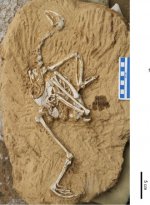Fred Ruhe
Well-known member

Zhiheng Li, Julia A. Clarke, Chad M. Eliason, Thomas A. Stidham, Tao Deng & Zhonghe Zhou, 2018
Vocal specialization through tracheal elongation in an extinct Miocene pheasant from China.
Scientific Reports 8, Article number: 8099 (2018)
doi:10.1038/s41598-018-26178-x
https://www.nature.com/articles/s41598-018-26178-x
Free pdf: https://www.nature.com/articles/s41598-018-26178-x.pdf
Abstract: Modifications to the upper vocal tract involving hyper-elongated tracheae have evolved many times within crown birds, and their evolution has been linked to a ‘size exaggeration’ hypothesis in acoustic signaling and communication, whereby smaller-sized birds can produce louder sounds. A fossil skeleton of a new extinct species of wildfowl (Galliformes: Phasianidae) from the late Miocene of China, preserves an elongated, coiled trachea that represents the oldest fossil record of this vocal modification in birds and the first documentation of its evolution within pheasants. The phylogenetic position of this species within Phasianidae has not been fully resolved, but appears to document a separate independent origination of this vocal modification within Galliformes. The fossil preserves a coiled section of the trachea and other remains supporting a tracheal length longer than the bird’s body. This extinct species likely produced vocalizations with a lower fundamental frequency and reduced harmonics compared to similarly-sized pheasants. The independent evolution of this vocal feature in galliforms living in both open and closed habitats does not appear to be correlated with other factors of biology or its open savanna-like habitat. Features present in the fossil that are typically associated with sexual dimorphism suggest that sexual selection may have resulted in the evolution of both the morphology and vocalization mechanism in this extinct species.
Systematic paleontology
AVES Linnaeus, 1758
GALLIFORMES Linnaeus, 1758
PHASIANIDAE Vigors, 1825
Panraogallus hezhengensis gen et sp. nov.
Etymology. The genus name is the pinyin of the Chinese characters meaning ‘coiling’ and the Latin for ‘chicken,’ referring to the preserved elongate trachea in this species. The specific epithet, ‘hezhengensis’ refers to Hezheng area in the Linxia Basin of Gansu Province where abundant fossils, including the holotype, have been collected.
Holotype. The holotype specimen of Panraogallus hezhengensis is HMV 1876 (HMV, Hezheng Paleozoological Museum, Vertebrate Collection, Gansu
Province, China), a nearly complete skeleton from a young adult individual.
It describes Panraogallus hezhengensis gen et sp. nov.
News:
http://english.ivpp.cas.cn/rh/rp/201805/t20180525_192866.html
Enjoy,
Fred
Vocal specialization through tracheal elongation in an extinct Miocene pheasant from China.
Scientific Reports 8, Article number: 8099 (2018)
doi:10.1038/s41598-018-26178-x
https://www.nature.com/articles/s41598-018-26178-x
Free pdf: https://www.nature.com/articles/s41598-018-26178-x.pdf
Abstract: Modifications to the upper vocal tract involving hyper-elongated tracheae have evolved many times within crown birds, and their evolution has been linked to a ‘size exaggeration’ hypothesis in acoustic signaling and communication, whereby smaller-sized birds can produce louder sounds. A fossil skeleton of a new extinct species of wildfowl (Galliformes: Phasianidae) from the late Miocene of China, preserves an elongated, coiled trachea that represents the oldest fossil record of this vocal modification in birds and the first documentation of its evolution within pheasants. The phylogenetic position of this species within Phasianidae has not been fully resolved, but appears to document a separate independent origination of this vocal modification within Galliformes. The fossil preserves a coiled section of the trachea and other remains supporting a tracheal length longer than the bird’s body. This extinct species likely produced vocalizations with a lower fundamental frequency and reduced harmonics compared to similarly-sized pheasants. The independent evolution of this vocal feature in galliforms living in both open and closed habitats does not appear to be correlated with other factors of biology or its open savanna-like habitat. Features present in the fossil that are typically associated with sexual dimorphism suggest that sexual selection may have resulted in the evolution of both the morphology and vocalization mechanism in this extinct species.
Systematic paleontology
AVES Linnaeus, 1758
GALLIFORMES Linnaeus, 1758
PHASIANIDAE Vigors, 1825
Panraogallus hezhengensis gen et sp. nov.
Etymology. The genus name is the pinyin of the Chinese characters meaning ‘coiling’ and the Latin for ‘chicken,’ referring to the preserved elongate trachea in this species. The specific epithet, ‘hezhengensis’ refers to Hezheng area in the Linxia Basin of Gansu Province where abundant fossils, including the holotype, have been collected.
Holotype. The holotype specimen of Panraogallus hezhengensis is HMV 1876 (HMV, Hezheng Paleozoological Museum, Vertebrate Collection, Gansu
Province, China), a nearly complete skeleton from a young adult individual.
It describes Panraogallus hezhengensis gen et sp. nov.
News:
http://english.ivpp.cas.cn/rh/rp/201805/t20180525_192866.html
Enjoy,
Fred




